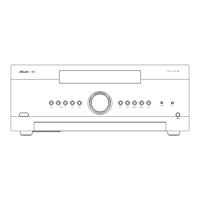E-38
customising
the remote
Code learning
e supplied remote comes with a complete library
of pre-programmed codes. Aer you have set up the
remote for your device, you may nd that there are one
or more functions on your original remote which do not
have a place on the keypad. For convenience, the remote
oers a Code Learning feature that allows you to copy
up to 16 functions from an original remote control onto
the remote keypad.
Before you start, make sure that:
< e original remote control is working correctly.
< e remotes are not pointing at your device.
< e remotes have fresh batteries.
< e remotes are not in direct sunlight or under
strong uorescent lights.
NOTE
Learned functions are mode-dependent. You could
assign up to eight dierent functions to a single key
– a separate learned function for each mode.
Direct code setup (Method 1)
e rst method is to program the remote with the
3-digit code number for the device you wish to control
– see “device code tables”. Make a note of the suggested
number or numbers – the most popular code is listed
rst. Now power on the device.
1. Press the Device key for the product you want to set
up, together with the 1 key. Hold down both buttons
for three seconds until the LED stays lit.
You are now in setup mode, and you can release the
buttons.
2. Enter a 3-digit code for the device.
If the 3-digit code number you entered is correct for
the device, it will turn o. If it doesn’t turn o, enter
the next code number from your list until the device
does turn o.
3. Once you have found the correct code, press the
Device key again. e LED blinks three times
to conrm that the code has been
successfully stored.
Library search setup (Method 2)
Library search allows you to scan through all the
codes contained in the remote’s memory. It can take a
lot longer than the previous method, so only use this
method if:
< Your device does not respond to the remote aer
you have tried all the codes listed for your brand.
< Your brand is not listed at all in the Device Code
tables.
1. Press the Device key for the product you want to set
up, together with the 1 key. Hold down both buttons
for three seconds until the LED stays lit.
2. Point the remote control at the product you wish
to control and press the
button on the
navigation pad. Each time the
button
is pressed, the code counts up (or down) one code
number with a signal to power o the device.
3. Continue pressing the up or down button, in
approximately one second intervals, until the device
turns o. (DO NOT alternate the up and down
button – you need to move in only one direction.)
4. To store the correct code, press the Device key again.
e LED blinks three times
to conrm
that the code has been successfully stored.
Learning setup (Method 3)
e third method involves ‘teaching’ the Arcam remote
from the original remote for the device. e two remotes
should be facing each other, about 10cm apart.
1. Press the Device key for the product you want to set
up, together with the 3 key. Hold down both buttons
for three seconds until the LED stays lit.
2. Press the button on the Arcam remote that you
want to assign a command to. e LED blinks once
indicating that the remote is ready to learn the
command.
3. Press and hold the appropriate key on the other
remote until the LED blinks twice
. is
indicates the Arcam remote has learned the
command from your other remote.
4. Continue learning the commands from your other
remote by pressing the next button on the remote
and repeating steps 2 and 3.
5. Once the remote has learned all the selected
commands, press and hold the Device key you used
to enter learning together with the Numeric 3 key to
store the learned commands.
NOTE
If the Arcam remote LED blinks ve times
there was an error in the learning
process. In this case, please start the Learning Setup
from the start.
e
AMP and RADIO keys do not learn commands.
Important notes
< Once you start a Code Learning session, you have
approximately ten seconds to conduct each step. Any
longer, and a timeout means that you’ll have to start
the process again.
< e Learning feature is mode-specic – you can
copy one feature per mode onto a key.
< e remote can learn approximately 16 functions
in total.
< To replace a learned function, simply assign a new
function to the same key.
< Learned functions are retained when you change
batteries.
< If Code Learning fails, try altering the distance
between the two remotes; make sure that the
ambient light is not too bright.
Deleting the learned data
To delete all the learned data for a device:
1. Press the Device key for the product you want to set
up, together with the 3 key. Hold down both buttons
for three seconds until the LED stays lit.
2. Press and hold down the Device key for the product
that you want to erase, together with the
key for
three seconds until the LED blinks twice
.
3. If any further key press is not made for 30 seconds
aer the LED blinks twice
, the remote leaves
erase mode without deleting the learned data.
4. If you press the Device key one more time within
30 seconds aer LED blinks twice
, you can
nish the erase mode deleting all the data learned on
the Device. e LED blinks three times
to conrm.
NOTE
On the following pages, a single ‘blink’ of the
remote’s power LED is indicated by the symbol

